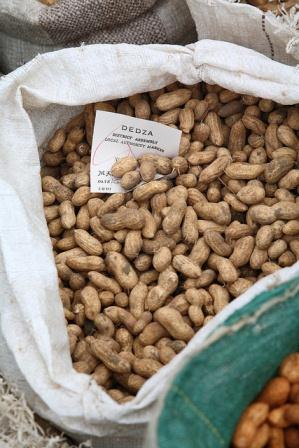July 17 — President Barack Obama need look no further than Malawi to support his argument that with the right seeds, fertilizers and transport, Africa can feed itself.
Once the victim of intermittent famines that left 40 percent of the population dependent on international aid just four years ago, Malawi has become a food exporter. Farmers credit a government program of subsidizing fertilizers for the turnaround.
“The world faces massive food shortages, but we have a lesson we can offer to the world,” President Bingu wa Mutharika, who was re-elected in May, told reporters this week. “Our subsidy program is a success and we want other countries to learn from us.”
Other African countries may now get the funds to follow Malawi: The Group of Eight nations on July 10 approved $20 billion in aid over three years to help poor farmers worldwide, mostly through cheaper access to fertilizers and seed.
Neighboring Tanzania began a fertilizer-subsidy program last December. Kenya had already announced plans for a subsidy system to turn it into a net food exporter by 2012, while Uganda increased agricultural spending by 47 percent in the budget announced on June 11.
“There is no reason why Africa cannot be self-sufficient when it comes to food,” Obama, 47, told reporters on July 10 at the G-8 summit in L’Aquila, Italy. “It has sufficient arable land. What’s lacking is the right seeds, the right irrigation, but also the kinds of institutional mechanisms that ensure that a farmer is going to be able to grow crops, get them to market, get a fair price.”
$5 a Day
“Before the subsidies came in during 2005, our crops were poor because we couldn’t afford fertilizer,” said Luckmore Banda, looking out over 5-foot-high corn stalks sprouting from every square inch of available land at his homestead outside Malawi’s commercial capital, Blantyre. “Now, things are on the up and up. Our production is rising and our income is rising.”
Banda, 62, says the subsidies helped lift his income to $5 a day from less than $1 four years ago. About 7.2 million small- scale farmers in a country of 14.3 million have received the subsidies over four years, Treasury Secretary Randson Mwadiwa said in an interview.
Malawi expects to produce an estimated 3.7 million metric tons of corn this year, up 36 percent from 2008 and exceeding the 2.4 million tons needed for self-sufficiency, Finance Minister Ken Kandodo Banda said in a July 3 interview.
Corn Output Rising
Over the last five years, Malawi has increased its corn production by 57 percent, more than any of the other nine countries in Southern Africa, the UN Food and Agriculture Organization said in a report published yesterday.
While Malawi will replenish its grain stores this year, the United Nations has warned that the number of people suffering chronic hunger worldwide will rise by 100 million to 1.02 billion, 15 percent of the world’s 6.8 billion population, this year.
In 2005, prior to the program, a combination of drought and depleted soils made 5 million people in Malawi dependent on food handouts, according to the government and the UN Development Program. None is now.
While the World Bank says Malawi’s crop estimates may be too high and that good rains accounted for much of the increase, Agriculture Secretary Andrew Daudi said in an interview that “the surplus of corn production can be attributed entirely to the subsidy program.”
Expanding Economy
Malawi’s economy has expanded an average of 6.6 percent a year since 2004, while the percentage of people living on less than $1 a day has fallen to 40 percent from 52 percent, the Ministry of Finance said on May 15. Per capita income rose to $237 per year from $175 over the same period.
The subsidies work through vouchers that farmers can redeem for a 50-kilogram (110-pound) bag of fertilizer, covering about 70 percent of the cost.
“An application of even a few kilos of fertilizer doubles the output,” said Ajay Vashee. He is president of the Paris- based International Federation of Agricultural Producers and a farmer in Zambia. Malawi’s experience “can be replicated provided there are certain safeguards,” Vashee said. “We need to know the true cost of the program.”
The subsidies soaked up about 15 percent of Malawi’s national budget and accounted for about 80 percent of spending by the Agriculture Ministry, according to David Rohrbach, the World Bank’s representative in Malawi.
Budget Impact
The government will spend 17.8 billion kwacha ($127 million) on the program this year, down 39 percent from 2008 due to an expected equivalent drop in fertilizer costs, Minister Banda said on July 3.
In addition to using up funds, the subsidies may not be producing the harvest estimated by the government. Encouraged by a bumper harvest in 2007, the government granted licenses for exports of 450,000 tons, yet exporters could only access 283,000 tons, according to a report by the Pretoria, South Africa-based Regional Strategic Agricultural Knowledge Support System for Southern Africa, which promotes agricultural development.
Whatever the reservations about the system, Malawi’s poor have clearly benefited.
“I watched many, many people die of hunger, especially in 2005,” said Jonas Chifumbo, another Blantyre farmer. “It was a horrifying experience, there was just death everywhere. Now the very poor are getting help.”

.jpeg&w=60&q=100&h=60)




.jpeg&w=60&q=100&h=60)





